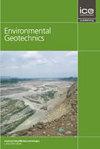单根护栏柱冲击特性的数值模拟与研究
IF 2.2
4区 工程技术
Q3 ENGINEERING, GEOLOGICAL
引用次数: 0
摘要
车辆约束系统是道路安全工程中重要的硬件组成部分。车辆约束系统的认证过程包括全尺寸碰撞试验、部件试验和这些试验的数值模拟。为了获得可靠的碰撞试验模拟结果,必须对土-桩相互作用进行建模,以真实地捕捉其行为。在实践中,没有标准化的方法来模拟土壤-桩的相互作用。本文采用有限元方法研究了准静态和动态冲击荷载作用下的桩土响应。为此目的应用了两种不同的建模技术。第一种方法是有限元连续体方法,采用先进的欠塑性本构关系对土壤进行建模,并使用实验室测试数据进行校准。第二种方法是集总参数模型,介绍了基于土壤基本特性的系统参数校准方法。作者在标准路肩材料的单桩上进行了一系列全尺寸现场试验,验证了数值模型的有效性。结果表明,在相同的参数集下,欠塑性本构关系能较真实地反映不同荷载条件下的桩体行为。所引入的集总参数模型以较高的计算效率充分地模拟了桩的行为,这在模拟多个桩时是非常重要的。参数化研究表明,土的相对密度、桩的埋置长度和后截面模量决定了单桩的侧向承载性能和耗能能力。本文章由计算机程序翻译,如有差异,请以英文原文为准。
Numerical Modelling and Investigation of the Impact Behaviour of Single Guardrail Posts
Vehicle restraint systems are vital hardware elements in road safety engineering. The certification process of a vehicle restraint system includes full-scale crash tests, component testing and numerical simulation of these tests. To achieve reliable crash test simulation results, the soil–post interaction must be modelled to capture the behaviour realistically. There is no standardised approach for modelling the soil–post interaction in the praxis. In this study, the finite element method is utilised to investigate the soil–post response under quasi-static and dynamic impact loading. Two different modelling techniques are applied for this purpose. The first technique is the finite element continuum method, with the soil modelled using the advanced hypoplastic constitutive relation and calibrated using laboratory test data. The second technique is a lumped-parameter model, for which a systematic parameters calibration routine using basic soil properties is introduced. The numerical models are validated using a series of full-scale field tests performed by the authors on single posts in standard road shoulder materials. The performance comparison of the investigated modelling techniques shows that the hypoplastic constitutive relation can capture the post behaviour realistically under different loading conditions using the same parameter set. The introduced lumped-parameter model adequately simulates the post behaviour with high computational efficiency, which is very important when simulating several posts. The conducted parametric study elucidates that the soil’s relative density, the post’s embedment length, and the post-section modulus govern the single post’s lateral load-bearing behaviour and energy dissipation capacity.
求助全文
通过发布文献求助,成功后即可免费获取论文全文。
去求助
来源期刊

Environmental geotechnics
Environmental Science-Water Science and Technology
CiteScore
6.20
自引率
18.20%
发文量
53
期刊介绍:
In 21st century living, engineers and researchers need to deal with growing problems related to climate change, oil and water storage, handling, storage and disposal of toxic and hazardous wastes, remediation of contaminated sites, sustainable development and energy derived from the ground.
Environmental Geotechnics aims to disseminate knowledge and provides a fresh perspective regarding the basic concepts, theory, techniques and field applicability of innovative testing and analysis methodologies and engineering practices in geoenvironmental engineering.
The journal''s Editor in Chief is a Member of the Committee on Publication Ethics.
All relevant papers are carefully considered, vetted by a distinguished team of international experts and rapidly published. Full research papers, short communications and comprehensive review articles are published under the following broad subject categories:
geochemistry and geohydrology,
soil and rock physics, biological processes in soil, soil-atmosphere interaction,
electrical, electromagnetic and thermal characteristics of porous media,
waste management, utilization of wastes, multiphase science, landslide wasting,
soil and water conservation,
sensor development and applications,
the impact of climatic changes on geoenvironmental, geothermal/ground-source energy, carbon sequestration, oil and gas extraction techniques,
uncertainty, reliability and risk, monitoring and forensic geotechnics.
 求助内容:
求助内容: 应助结果提醒方式:
应助结果提醒方式:


